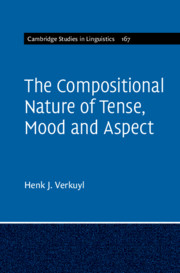Book contents
- Frontmatter
- Dedication
- Contents
- List of Figures
- List of Tables
- Preface
- 1 Introductory Chapter
- 2 How to Deal with the Long Tradition of Going Ternary?
- 3 Binary Tense Structure
- 4 Naive Physics and Aspectual Composition
- 5 Levels of Interaction between Aspect and Tense
- 6 Binary Tense Structure and Adverbial Modification
- 7 How to Deal Binarily with ...?
- 8 Tense, Mood and Aspect
- Appendix
- Bibliography
- Author Index
- Subject Index
8 - Tense, Mood and Aspect
Published online by Cambridge University Press: 08 October 2021
- Frontmatter
- Dedication
- Contents
- List of Figures
- List of Tables
- Preface
- 1 Introductory Chapter
- 2 How to Deal with the Long Tradition of Going Ternary?
- 3 Binary Tense Structure
- 4 Naive Physics and Aspectual Composition
- 5 Levels of Interaction between Aspect and Tense
- 6 Binary Tense Structure and Adverbial Modification
- 7 How to Deal Binarily with ...?
- 8 Tense, Mood and Aspect
- Appendix
- Bibliography
- Author Index
- Subject Index
Summary
Chapter 8 focusses on the nature of the second binary opposition, the one between SYN and POST. In view of the fact that POST can be argued to be modal, the leading idea is that the opposition can be understood in terms of a strict opposition between realis (indicative) and different forms of irrealis (subjunctive, conjunctive, etc). The chapter culminates in reaching S’ at the end of the journey from the tenseless bottom of phrase structure to the tensed top S’ including all the distinctions made on the way between the different factors summarized at the end of Chapter 5. This makes it possible to see binary tense structure as expressing tense, mood and aspect in a systematic compositional way.
Keywords
- Type
- Chapter
- Information
- The Compositional Nature of Tense, Mood and Aspect , pp. 253 - 289Publisher: Cambridge University PressPrint publication year: 2021

